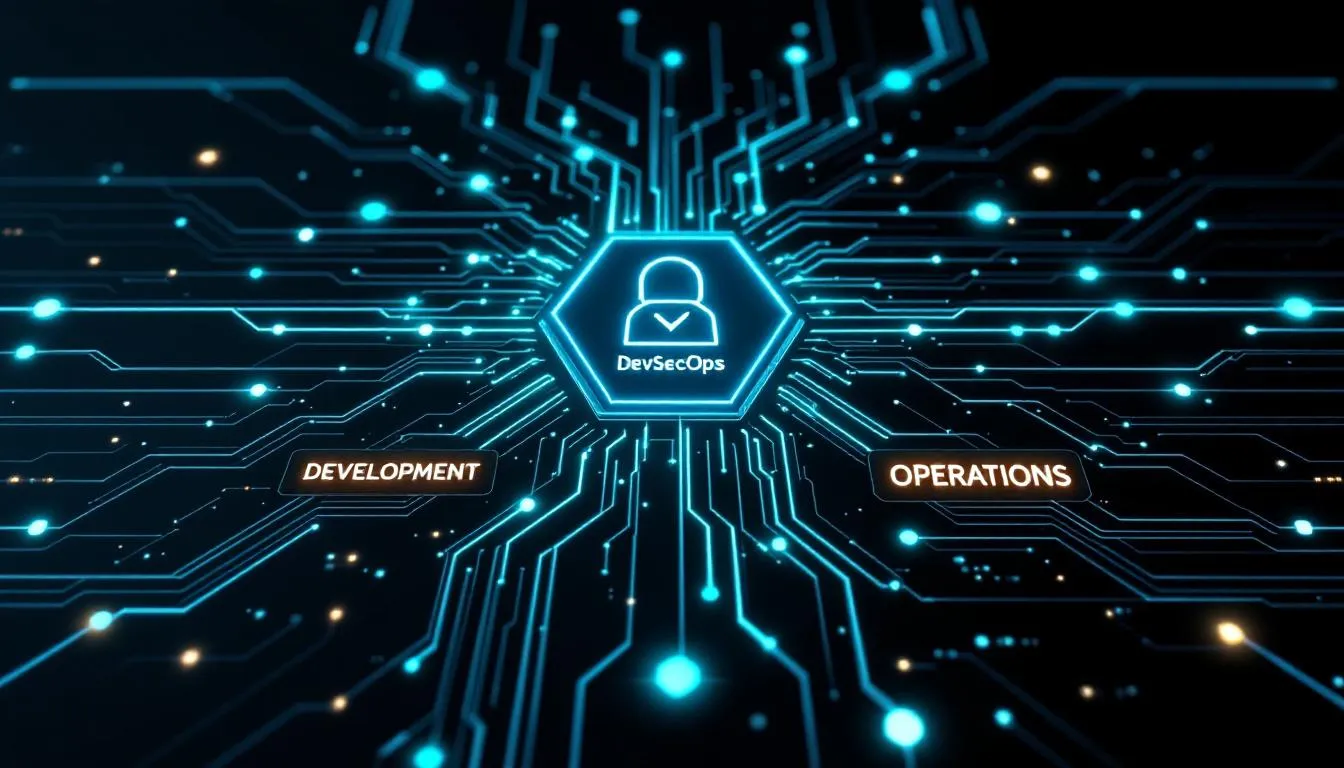Curious about the role of DevSecOps in enhancing software security? DevSecOps embeds security into every step of software development, ensuring potential risks are managed early. This practice involves automation, continuous monitoring, and collaboration among teams to create robust security frameworks. In this article, we explore how DevSecOps transforms security practices and the key benefits it offers to organizations.
Understanding DevSecOps and Its Importance
DevSecOps is the practice of embedding security practices into the DevOps workflow, fundamentally transforming software development and operations teams’ approach to security. Unlike traditional DevOps, which focuses primarily on development and operations, DevSecOps integrates security into every phase of the development process, ensuring that security is not an afterthought but a core component. This integration is achieved through automation, which embeds security checks and balances throughout the development lifecycle.
In today’s digital age, DevSecOps plays a critical role. With increasing cyber threats, organizations must deliver software quickly, reliably, and securely. Embedding security practices from the start helps mitigate these threats and enhances collaboration between development, security, and operations teams.
DevSecOps brings numerous benefits, such as reducing security risks, enhancing resilience, and enabling the rapid delivery of secure software. It helps organizations confidently navigate complex threats, delivering robust solutions that meet high security standards.
Key Principles of DevSecOps
DevSecOps transforms the software development culture by making security a shared responsibility among all teams. This collaborative approach encourages every team member to own security, leading to quicker identification and resolution of vulnerabilities. Enhanced cooperation between development, security, and operations teams results in better project outcomes, aligning security with business objectives.
The CALMS framework—central to DevSecOps—consists of:
- Culture
- Automation
- Lean IT
- Measurement
- Sharing
Automation enforces security policies, facilitates testing, and monitors the software development lifecycle to automate security controls. Continuous improvement, driven by regular feedback and iterative processes, ensures that security measures evolve and improve.
Fast feedback loops are a key principle of DevSecOps, enabling teams to resolve security issues quickly and minimize their impact on production. Incorporating security at every stage of the software development lifecycle helps proactively minimize security risks and prevent critical vulnerabilities.
Integrating Security Early in the Development Process
Integrating security practices within the modern software development lifecycle (SDLC) helps identify security vulnerabilities at every step of the entire development process, not just post-development. Treating security as an integral feature of software from the earliest stages reduces both the time and cost associated with fixing vulnerabilities and allows teams to integrate security effectively.
The shift-left approach in the devsecops approach addresses security concerns early in the development cycle, allowing developers to:
- Identify and mitigate vulnerabilities during coding.
- Enhance security throughout the development lifecycle through early detection of security risks.
- Ensure vulnerabilities are promptly identified and addressed before exploitation via real-time security monitoring, taking a proactive approach.
Security training for development teams is crucial for integrating security early in the development process. When developers can independently identify and address security risks, it fosters a culture of security awareness and collaboration among all security teams. This cultural shift is essential for successful DevSecOps implementation, creating a secure development environment.
Automating Security Testing
Automation in DevSecOps automates:
- Security testing
- Vulnerability scanning
- Compliance checks within CI/CD pipelines This facilitates quicker software releases while maintaining rigorous security standards. Dynamic Application Security Testing (DAST) evaluates live applications during runtime, uncovering vulnerabilities that static code analysis might miss, and is effective in identifying misconfigurations and runtime issues.
Static Application Security Testing (SAST) complements DAST by identifying security weaknesses within the source code before deployment. Early detection of flaws helps meet compliance with regulations like HIPAA and PCI DSS, ensuring vulnerabilities are addressed before impacting production. Integrating both SAST and DAST within the CI/CD pipeline enhances application security throughout development stages.
Automated security scanning tools improve the detection of anomalies and unauthorized activities during the software development process. Using the right tools for automating security testing helps organizations meet regulatory requirements efficiently and ensures consistent manual security checks. This comprehensive approach, including new security tools and interactive application security testing, is vital for maintaining a secure development environment.
Continuous Monitoring and Incident Response
Continuous monitoring is a cornerstone of DevSecOps, enabling the quick identification and addressing of security threats to maintain a secure environment. Proactive monitoring is essential for identifying and mitigating security risks before they lead to breaches, enhancing overall cybersecurity. Anomaly detection identifies potential threats or unusual activities suggesting a breach.
Integrating AI and machine learning in monitoring enhances threat detection by identifying unusual patterns in user behavior and application traffic. These advanced technologies provide real-time insights into performance, user experience, and potential security issues, enabling swift responses to emerging threats.
Comprehensive application monitoring ensures security incidents and security breaches are promptly detected and addressed, minimizing their impact. Continuous security through proactive monitoring and incident response helps organizations build a resilient security posture that protects against evolving cyber threats.
Addressing Common Challenges in DevSecOps Implementation
Implementing DevSecOps comes with challenges, with cultural resistance being a significant obstacle. Highlighting shared accountability and success stories can facilitate a cultural shift, breaking down organizational barriers and aligning security goals with development objectives.
Another challenge is the lack of necessary security expertise among developers and stakeholders, undermining effective DevSecOps implementation. Cross-functional teams and relevant certifications can address these skill gaps, ensuring all team members are equipped with the required knowledge and expertise.
The absence of security assurance across business and project levels can hinder DevSecOps implementation. Promoting an environment where all team members share security insights increases vigilance against potential security flaws and fosters a culture of continuous improvement to address security issues, compromising security. Addressing these challenges is crucial for successful DevSecOps adoption.
Benefits of Adopting DevSecOps Practices

Adopting DevSecOps practices embeds security checks throughout the CI/CD process. This approach mitigates risks and speeds up software delivery by identifying and addressing security issues before deployment. Reduced time between vulnerability discovery and remediation enhances overall security and software quality.
Continuous monitoring supports compliance by generating audit trails and security reports required by regulations like HIPAA and GDPR. Maintaining security standards are met during all development stages, and continuous integration enhances compliance and reduces the risk of regulatory penalties through regular security audits.
Automating infrastructure delivery reduces the time-to-market for new applications, providing a competitive edge in the fast-paced development pipeline landscape. The proactive and cooperative nature of DevSecOps fosters a culture of shared responsibility and infrastructure security continuous improvement.
Organizations adopting DevSecOps methodologies achieve higher levels of security, reliability, and efficiency, ultimately delivering robust software solutions that meet high security and quality standards.
Case Study: Shark Byte's Approach to DevSecOps
Based in Ottawa, Ontario, Shark Byte is a custom software development company that prides itself on guiding clients to success and creating intelligent solutions that minimize risks and maximize rewards. Their approach to software development is detail-oriented and full of care, ensuring that every aspect of the development process is meticulously planned and executed.
Shark Byte’s implementation of DevSecOps showcases their commitment to security and quality. Integrating security into every phase of their development process ensures vulnerabilities are addressed proactively, reducing security incident risks. Using automated security testing, including both Dynamic Application Security Testing (DAST) and Static Application Security Testing (SAST), enhances their applications’ security throughout development stages.
Shark Byte’s success in implementing DevSecOps reflects their dedication to best practices and continuous improvement in security measures. Fostering a culture of collaboration and proactive security sets a benchmark for other organizations aiming to enhance software security through DevSecOps.
Future Trends in DevSecOps
The future of DevSecOps is promising, with emerging trends set to shape the landscape. Key aspects include:
- Integrating artificial intelligence to streamline security processes and enhance threat detection.
- AI-driven security tools analyzing vast amounts of data in real-time.
- Providing insights that are difficult to achieve through manual processes.
Advancements in container security will focus on runtime protection and vulnerability management. As more organizations adopt containerized environments, securing these containers throughout their lifecycle becomes crucial. DevSecOps practices will evolve to address these unique security challenges, providing more robust and comprehensive solutions.
Cloud-native security solutions are evolving to provide more comprehensive protection against emerging threats, including the latest security threats. As organizations migrate to the cloud, integrating security into cloud-native applications and infrastructure becomes essential. These trends highlight the ongoing evolution of DevSecOps and the need for organizations to stay ahead by adopting the latest security practices and technologies.
Summary
In summary, DevSecOps represents a transformative approach to software security, embedding security practices throughout the development lifecycle. By fostering a culture of shared responsibility, integrating security early in the development process, and leveraging automation and continuous monitoring, organizations can significantly enhance their software security and resilience against cyber threats.
Adopting DevSecOps practices offers numerous benefits, from reducing security risks and improving compliance to enabling faster software delivery and fostering continuous improvement. As the landscape of software development continues to evolve, embracing DevSecOps will be crucial for organizations seeking to deliver secure, high-quality software solutions.



